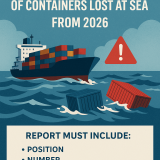This September, government experts on the health of plants and crops will gather in London for the first ever International Conference on Plant Health. This high-level meeting organized by the secretariat of the UN’s International Plant Protection Convention (IPPC) and hosted by the UK government will review the state of the world’s natural and agricultural plant resources, and what can be done to protect and enhance them.
Given the combined pressures of climate change, water shortages, destructive pests and disease the conference could make for a sobering experience.
In the two days preceding the conference, and in the same London venue, a smaller, and even more specialized group consisting of international trade bodies, shipping industry representatives and national plant protection and bio-security agencies will meet to review one of the many ways that invasive and destructive pests can pass from one country to another – by ‘hitch-hiking’ a ride in, or on, any of the 240 million freight container shipments that are made by sea every year.
The International Workshop on Reducing the Introduction of Pests Through the Sea Container Pathway (19-20th September) will be a wake-up call to all parties involved in international container shipping and logistics.
Pest impacts
The threat to a nation’s food supply or its agricultural industries may not be obvious just because a few insects find their way into a forty-foot steel container. But history is littered with examples of how highly destructive pests have entered a country’s ecosystem through imported goods or packaging, and wreaked devastation on native plant species.
The Great Potato Blight, that caused famine and mass migration from Ireland in the 1840s, is thought to have been caused by the import of the pest responsible from Central America to Europe aboard the sailing ships of the day. In the 20th century, large numbers of trees in the US and Europe were lost to disease and pests thought to have been unknowingly imported as international trade spread.
Contamination is not just confined to ‘dirty’ cargoes. Last year, Australian authorities reported the detection of live pests in a consignment of baby clothes and equipment intercepted at the border. The UK government has related how a colony of invasive wasps found their way to the country having nested in the radiator grill of a brand new (and very expensive) motor car, being delivered to a showroom.
Inspections of containers arriving at borders carried out by national biosecurity agencies over the past few years suggest that the number of containers and cargoes infested by pests may be greater than feared.
National environment and agricultural ministries have been working through the IPPC to tackle this issue for several years and the London workshop has been convened to consider options for regulating the cleanliness of sea containers and setting standards for preventing their contamination by invasive pests.
Shippers will be familiar with ISPM-15, the IPPC’s existing standards for the pre-treatment and marking of timber used to block and brace cargoes in containers or used to make pallets and other packaging for transport. Could a similar International Standard for Phytosanitary Measure for the cleanliness of intermodal containers be in prospect?
Unilateral action
Several countries have already taken unilateral action to protect their native plant species against specific pests. Last year the Australian government introduced new requirements for the pre-treatment of containers imported from listed countries and carrying specific cargoes to protect against the introduction of the Khapra Beetle, a small insect that could devastate the country’s cereal grain crop were it to become established.
These rules supplemented existing measures to protect against introduction of the Brown Marmorated Stink Bug, a creature with effects as unpleasant as its name suggests! Failure to comply with these requirements will almost certainly result in a container being denied entry at the Australian border and possibly re-exported, ultimately at the shipper’s expense.
New Zealand has similar measures and there are controls too to protect against different pests that threaten other countries. Canada and the US are concerned about threats to their forests and their wheat crops; Fire Ants are a big threat to native species in Japan.
This is a live issue (in some senses literally!) and under active review by governments around the world. The possibility of new international mandatory measures on container cleanliness should command the attention of shippers everywhere.
Global developments
The Global Shippers Forum (GSF) has been monitoring and influencing these developments since 2018 when it was invited to join an IPPC Task Force set up to examine the threat to plant health posed by pest-contaminated containers and cargoes. That Task Force reported at the end of 2021 and set out a range of regulatory options for its parent body, the Commission for Phytosanitary Measures (CPM) to consider.
Crucially, it also warned that implementation of new mandatory requirements could impose significant new costs and risks to the fluidity of the international movement of containers and further disrupt world trade. GSF was clear in its opposition to new rules applying indiscriminately to every container shipment, urging that controls and resources be targeted instead on high-risk trade corridors and specific pest threats.
The work of developing any new measures will be taken forward by a CPM Focus Group, which will have the authority to make recommendations to its parent body, the Commission for Phytosanitary Measures (CPM). This month’s workshop in London will develop key ideas for the Focus Group to pursue. GSF is speaking at the event and will be ensuring shippers’ interests are represented and the scope and limits of responsibilities clearly defined.
GSF will also be represented on an industry advisory body that will be advising the new CPM Focus Group on the practicality and effectiveness of any new regulatory measures it may propose. GSF will also be making the case for a significant increase in the publicity given to this threat within the industry.
Pest contamination is an unintended consequence of international trade and awareness of its risks and consequences is relatively low. Much could be gained in a short time by raising awareness of the issue in the industry and the relatively simple ways of preventing it.
Not that there is any shortage of advice and guidance on how to pack containers safely and to keep them clear of invasive pests. The Code of Practice for Packing Cargo Transport Units (the CTU Code), a publication of three UN trade and transport organizations is the authoritative guide to container packing that all shippers and packers should be aware of, and familiar with.
The IPPC has also acknowledged the work done by the Cargo Integrity Group, a partnership of seven global trade and shipping organizations, including GSF, to develop a ‘Quick Guide’ to the provisions of the CTU Code. This included a ‘Container Packing Checklist’ of 34 questions about the manner of packing and securing of goods that should be answered affirmatively by the packer prior to dispatch of the container to a shipping line.
Simple nudges
Shippers should not wait to be confronted with new regulations before responding to this issue. Whether you are a buyer or a seller of goods, the standards of care with which they are packed into the containers that will transport them should be a core part of your quality checks and specifications to suppliers or contractors.
Is the risk of accidental contamination by pests understood? Are the recommended precautions taken during the packing and storage of the container? Have staff been trained in what to look out for and what to do if they find evidence of infestation or contamination? Simple nudges could make a big difference.
Hitch-hiking in cargoes is not the only way invasive pests can move between countries. The containers themselves and the conditions under which they are stored in ports and by shipping lines are also crucial to preventing their contamination.
The efforts of shippers to avoid contamination during packing will be wasted if the empty container supplied to them is already infested, or dispatched containers are stored under the wrong conditions awaiting shipment. Container cleanliness is an industry-wide issue and responsibility.
Fewer than one percent of alien species that enter a country are thought to become invasive but where this has happened the effects on economies, landscapes and peoples’ lives has been traumatic and permanent.
Containers can become contaminated at any point in their journeys by sea but keeping bugs out of the boxes as they are packed is a responsibility that shippers and packers are likely to become more accountable for in the future.
Source: https://maritimefairtrade.org/pest-attacks-cleanliness-of-freight-containers-matters/







